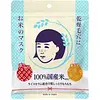What's inside
What's inside
 Key Ingredients
Key Ingredients

No key ingredients
 Benefits
Benefits

 Concerns
Concerns

 Ingredients Side-by-side
Ingredients Side-by-side

Water
Skin ConditioningGlycerin
HumectantPropylene Glycol
HumectantAlcohol Denat.
AntimicrobialStyrene/Vp Copolymer
Lactobacillus/Rice Ferment Filtrate
Skin ConditioningOryza Sativa Bran Oil
EmollientHydrolyzed Rice Bran Extract
Skin ConditioningGlycosphingolipids
EmollientGlucosyl Ceramide
Skin ConditioningAlpha-Glucan
HumectantButylene Glycol
HumectantXanthan Gum
EmulsifyingPolysorbate 80
EmulsifyingCitric Acid
BufferingSodium Citrate
BufferingPhenoxyethanol
PreservativeMethylparaben
PreservativeWater, Glycerin, Propylene Glycol, Alcohol Denat., Styrene/Vp Copolymer, Lactobacillus/Rice Ferment Filtrate, Oryza Sativa Bran Oil, Hydrolyzed Rice Bran Extract, Glycosphingolipids, Glucosyl Ceramide, Alpha-Glucan, Butylene Glycol, Xanthan Gum, Polysorbate 80, Citric Acid, Sodium Citrate, Phenoxyethanol, Methylparaben
Water
Skin ConditioningGlycerin
HumectantButylene Glycol
HumectantParaffinum Liquidum
EmollientAspergillus/Rice Ferment Extract
HumectantGalactomyces Ferment Filtrate
HumectantSaccharomyces/Xylinum/Black Tea Ferment
Skin ConditioningPolysorbate 80
EmulsifyingSorbitan Sesquioleate
EmulsifyingCarbomer
Emulsion StabilisingXanthan Gum
EmulsifyingDimethicone
EmollientTromethamine
BufferingDisodium EDTA
Allantoin
Skin ConditioningDipotassium Glycyrrhizate
Humectant1,2-Hexanediol
Skin ConditioningPropanediol
SolventCaprylyl Glycol
EmollientIllicium Verum Fruit Extract
PerfumingChlorphenesin
AntimicrobialPhenoxyethanol
PreservativeParfum
MaskingWater, Glycerin, Butylene Glycol, Paraffinum Liquidum, Aspergillus/Rice Ferment Extract, Galactomyces Ferment Filtrate, Saccharomyces/Xylinum/Black Tea Ferment, Polysorbate 80, Sorbitan Sesquioleate, Carbomer, Xanthan Gum, Dimethicone, Tromethamine, Disodium EDTA, Allantoin, Dipotassium Glycyrrhizate, 1,2-Hexanediol, Propanediol, Caprylyl Glycol, Illicium Verum Fruit Extract, Chlorphenesin, Phenoxyethanol, Parfum
 Reviews
Reviews

Ingredients Explained
These ingredients are found in both products.
Ingredients higher up in an ingredient list are typically present in a larger amount.
Butylene Glycol (or BG) is used within cosmetic products for a few different reasons:
Overall, Butylene Glycol is a safe and well-rounded ingredient that works well with other ingredients.
Though this ingredient works well with most skin types, some people with sensitive skin may experience a reaction such as allergic rashes, closed comedones, or itchiness.
Learn more about Butylene GlycolGlycerin is already naturally found in your skin. It helps moisturize and protect your skin.
A study from 2016 found glycerin to be more effective as a humectant than AHAs and hyaluronic acid.
As a humectant, it helps the skin stay hydrated by pulling moisture to your skin. The low molecular weight of glycerin allows it to pull moisture into the deeper layers of your skin.
Hydrated skin improves your skin barrier; Your skin barrier helps protect against irritants and bacteria.
Glycerin has also been found to have antimicrobial and antiviral properties. Due to these properties, glycerin is often used in wound and burn treatments.
In cosmetics, glycerin is usually derived from plants such as soybean or palm. However, it can also be sourced from animals, such as tallow or animal fat.
This ingredient is organic, colorless, odorless, and non-toxic.
Glycerin is the name for this ingredient in American English. British English uses Glycerol/Glycerine.
Learn more about GlycerinPhenoxyethanol is a preservative that has germicide, antimicrobial, and aromatic properties. Studies show that phenoxyethanol can prevent microbial growth. By itself, it has a scent that is similar to that of a rose.
It's often used in formulations along with Caprylyl Glycol to preserve the shelf life of products.
Polysorbate 80 is a surfactant and emulsifier. It is used to keep ingredients together, and prevent oils and waters from separating.
It is made from polyethoxylated sorbitan and oleic acid. This ingredient can be found in cosmetics, foods, and medicine. It is water-soluble.
Polysorbate 80 may not be fungal acne safe.
Learn more about Polysorbate 80Water. It's the most common cosmetic ingredient of all. You'll usually see it at the top of ingredient lists, meaning that it makes up the largest part of the product.
So why is it so popular? Water most often acts as a solvent - this means that it helps dissolve other ingredients into the formulation.
You'll also recognize water as that liquid we all need to stay alive. If you see this, drink a glass of water. Stay hydrated!
Learn more about WaterXanthan gum is used as a stabilizer and thickener within cosmetic products. It helps give products a sticky, thick feeling - preventing them from being too runny.
On the technical side of things, xanthan gum is a polysaccharide - a combination consisting of multiple sugar molecules bonded together.
Xanthan gum is a pretty common and great ingredient. It is a natural, non-toxic, non-irritating ingredient that is also commonly used in food products.
Learn more about Xanthan Gum